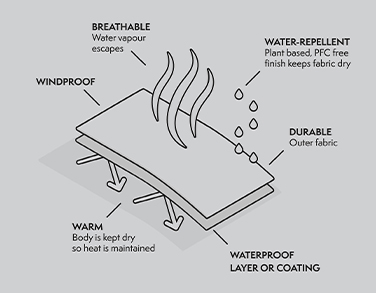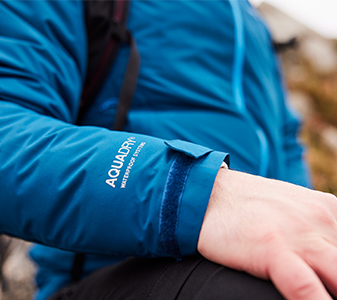
AQUADRY
Guaranteed Waterproof and Breathable Fabric

What Is AquaDry?
A combination of our waterproof and breathable coating or membrane and our technical outer fabrics delivers guaranteed levels of protection and comfort.
The outer face is treated with a DWR (Durable Water Repellent) finish to help keep the outer fabric drier for longer. The final product provides guaranteed breathability and all-round waterproof performance.
Understanding Our Waterproof and Breathability Ratings
A hydrostatic head test assesses a fabric's waterproofing abilities by subjecting it to increasing water pressure. The fabric is set up in a sealed tube, and water is applied gradually until leakage occurs. The pressure at which water penetrates the material determines its hydrostatic head rating, indicating its waterproof capacity. Fabrics with higher ratings are better suited for harsh weather conditions, while those with lower ratings are suitable for milder climates.
The test is conducted in adherence to industry standards set by organizations like ASTM and ISO, ensuring consistency and reliability. Manufacturers use this evaluation to determine the fabric's applicability in various outdoor gear. Ultimately, the test guarantees that outdoor enthusiasts can rely on their gear to provide effective protection against water, allowing them to enjoy outdoor activities confidently and comfortably, regardless of the weather. Hydrostatic Head then helps establish what people commonly refer to as 'waterproof ratings'.

Decoding Waterproof Ratings



Waterproof Rating Recommendations
You may now be thinking 'What waterproof rating do I need?', it can be confusing to try and understand what level of protection you need, and it all depends on your activity, location and of course the climate! We have the following recommendations below
Up To 5,000mm: Light Rain
5,000mm - 10,000mm: Average to Heavy Rain
10,000mm & Above: Very Heavy Rain

What Is Breathability?
Breathability is the amount of water vapour that can be let out through a fabric. Testing the breathability of our clothing involves checking how well the fabric allows sweat to escape. They use a method called moisture vapour transmission rate (MVTR) testing. This measures how quickly moisture passes through the fabric over a specific time. Higher MVTR values mean the fabric is more breathable, making it more comfortable during outdoor activities. Conducting these tests ensures clothing efficiently manages sweat, keeping adventurers cool and dry during their journeys.
Breathability has a similar scale to our waterproof rating, the higher the number, the more breathable the garment is going to be. Breathability is measured in g/m2/24hrs.
Ensuring Longevity and Performance

PFC's
PFCs are a group of chemicals that are known for their water and oil-repellent properties and have been identified as persistent, bio-accumulative and toxic. Known as 'forever chemicals', these synthetics can take as long as 1,000 years to degenerate. Meanwhile, they can make their way into waterways and the natural environment – including our own bodies and those of other living organisms.
Craghoppers have been proudly PFC free since 2019.